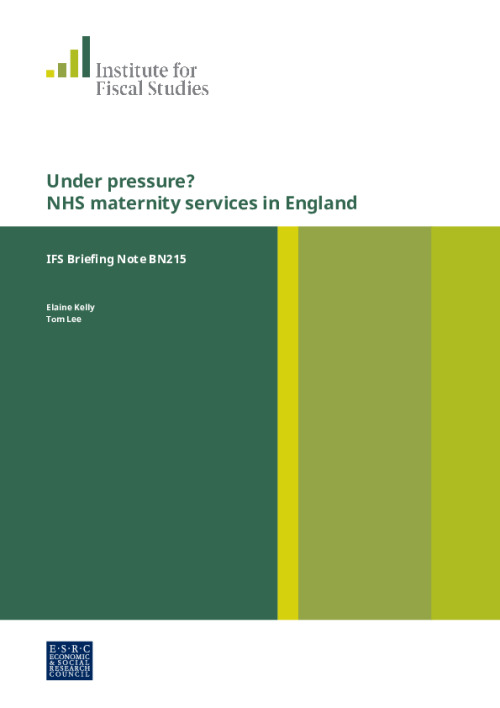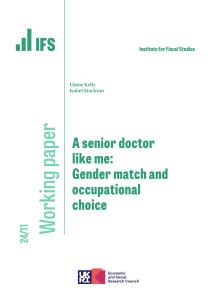NHS Maternity Units are more likely to close towards the end of the week and during holiday periods, pointing to staff availability as a source of pressure. This is a key finding of new research by the Institute for Fiscal Studies (IFS), funded by the Economic and Social Research Council (ESRC), examining sources of short-run and long-run pressures on maternity units in England.
Admission to hospital to give birth is the single largest cause of admission to NHS hospitals in England. In common with many NHS services, providers of maternity care are reporting pressures from increased demand, staffing shortages and programmes to improve the quality of care. How units respond to these challenges carries important implications for the health of mothers and babies, and the finances of NHS Acute Trusts.
This briefing note reviews the evidence on the long-run pressures faced by maternity units (MUs) from changes in the number of maternity admissions and the case mix. While the number of maternity cases has remained largely constant since 2010, the case mix continues to change, with women giving birth later in life and with more complex health conditions. There are implications for MUs if this evolving case mix of mothers requires more care in terms of staffing or other resources.
In addition to long-run pressures, MUs also face pressure from daily variations in admissions to MUs and (presumably unexpected) peaks in demand. This work also focuses on one potential consequence: whether the MU decides to close temporarily for new admissions to ensure the safety of mothers and babies currently on the unit. Volumes of temporary closures and their distribution across hospitals have been published elsewhere. The authors provide evidence on what may cause these closures, and what action may be needed to avoid the need for closures, as well as addressing wider pressures on MUs.
As expected the research shows that closures are related to the volume of admissions, both on the day of closure and on the day before closure. However, patterns of closure by day of the week and by month highlight that some of the factors that cause closures are predictable and extend beyond the inevitability of occasionally busy days. Closures are more likely on a Thursday, Friday and Saturday, but spikes in admissions are spread evenly across the week. Closures are also more likely to occur in the summer months and in December, the principal holiday periods.
Given that the number of beds is fixed across the week, the most likely explanation for variation in closures by day of the week and by month is the availability of staff. However, using the data available, it is not possible to say whether these patterns are attributable to difficulty in filling planned rosters, as many staff balance other caring commitments, or to ineffective planning and management. It is therefore hard to propose actions that could be taken to eliminate the day-of-the-week or seasonal effects, to estimate how much those actions would cost and to assess whether the cost would be justified given the potential benefits to women.
Finally, the note shows that hospitals that close more often are also more likely to breach their four-hour waiting-time targets, suggesting that the pressures felt by Acute Trusts extend beyond the maternity unit.
Key findings
- The number of maternity cases has stabilised since 2010 but the case mix has changed. The number of women giving birth has remained stable since 2010, after rapid increases in the 2000s. However, the trend towards older mothers with more complex health conditions has continued. This has implications for maternity units, as these mothers are on average more costly to care for.
- The changing case mix explains all of the rise in the number of C-sections in England between 2006 and 2014. The number of C-sections performed by NHS hospitals in England each year increased by 23,000 between 2006 and 2014. We estimate that all of this growth can be explained by the changing case mix of mothers giving birth. There is no evidence of a change in medical practice leading to more C-sections.
- Maternity units also face pressure from daily fluctuations in maternity admissions, and may have to close temporarily as a last resort. Daily maternity admissions to hospital fluctuate but the numbers of beds and on-duty staff are largely fixed. Maternity units may respond by calling in staff, delaying planned admissions or reducing length of stay. As a last resort, units may temporarily close. Such closures take place on fewer than 1 day in 200.
- Temporary closures are more common on days with high admissions, but variation in closure rates by day of the week and month suggest that it is difficult or costly to staff certain shifts. Maternity units are more likely to close when there are a higher number of admissions. However, closures are also more likely between Thursday and Saturday, when admissions are no higher than during the rest of the week. Closures also happen more frequently during holiday periods over the summer and at Christmas, suggesting a role for the availability of staff. How the cost of preventing such closures, in terms of increasing capacity or staffing levels, compares with the benefits to women of doing so is unclear, given the data available.
- Acute Trusts with higher numbers of maternity unit closures also more frequently breach the four-hour waiting-time target in A&E. There is almost no overlap between maternity and A&E patients, but Acute Trusts where maternity units close more often also breach the four-hour A&E waiting-time target with greater frequency. A&E patients in Acute Trusts that close more than 10 times in a year are 30% more likely to wait more than four hours than patients in Acute Trusts that do not close. This is the equivalent of an additional 2–3 patients in every 100 waiting more than four hours for treatment in A&E.
- Acute Trusts with the highest number of maternity unit closures serve larger local populations. Acute Trusts with maternity units that close more than 10 times per year have the largest average local populations measured according to the number of people for whom that is the nearest Acute Trust.
- Maternity unit closures are not associated with poorer-quality care at Acute Trust level. There is no evidence that Trusts that close, or close more often, have worse overall clinical quality across the Acute Trust. Indeed, the Standardised Hospital Mortality Indicator suggests that more maternity unit closures are associated with lower-than-expected death rates across all departments.










